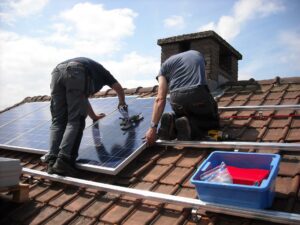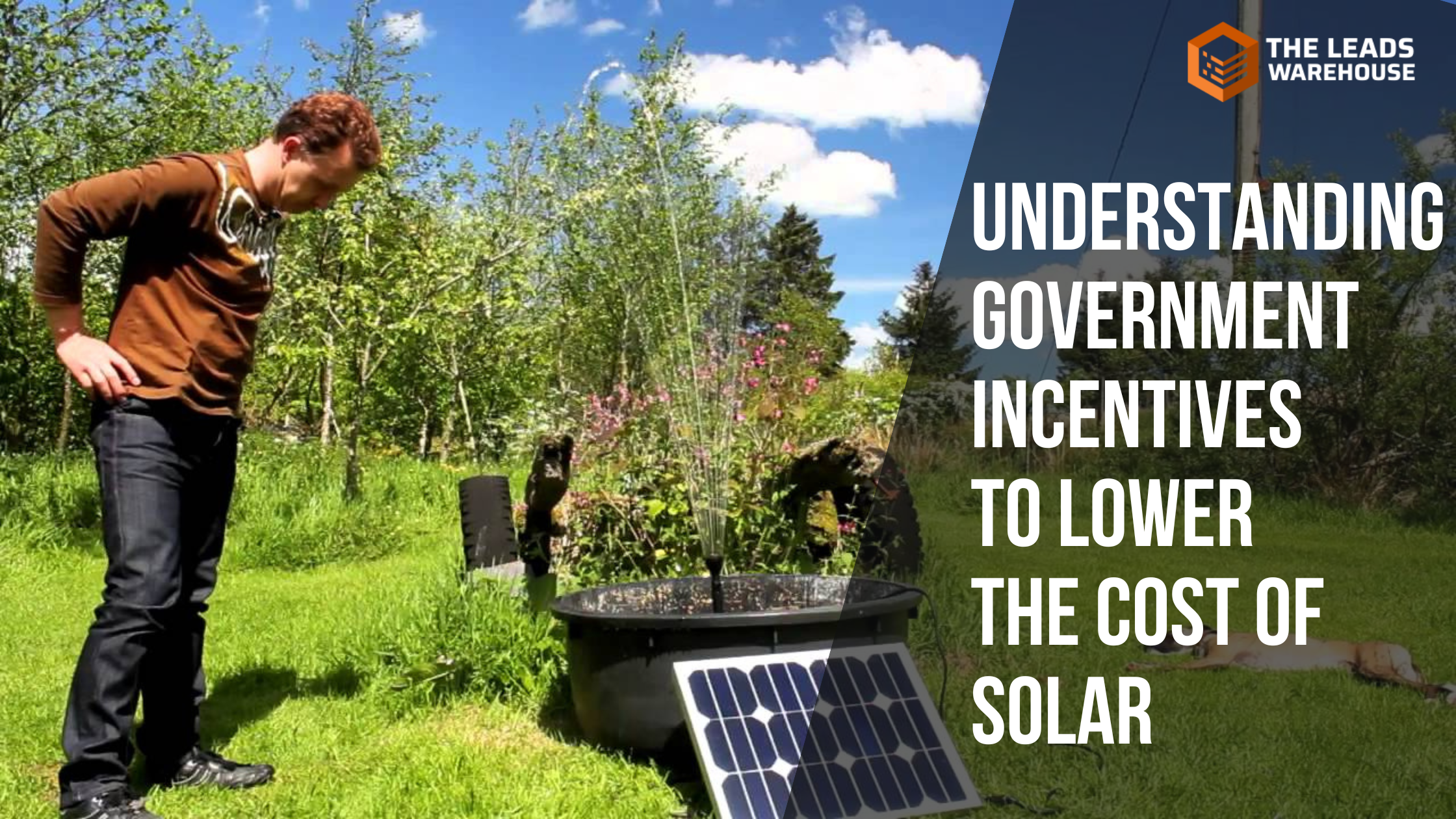Understanding Government Incentives to Lower the Cost of Solar – Aged Solar Leads

Homeowners aren’t aware of the available Government Rebates to greatly reduce the cost of solar. A study has shown 97% of Americans overestimate the cost of solar panels. Thinking they need an investment of $20,000.
The cost of solar panels has plummeted. And the Government is making a strong push to reduce emissions and reliance on “dirty” energy sources like fossil fuels. There are attractive programs to encourage homeowners and businesses to go solar. Aged solar leads have been making it easier on solar companies for years.
- Solar panel costs have come down due to technology improvements and increased competition between solar companies. In states like Arizona, you can now get a 5 kW solar system for under $10,000 after incentives.
- Homeowners will instantly see lower monthly electric bills, and in the 30+ states. With net metering you can make excellent returns by exporting their power for lots of money – upsell that Tesla battery!
- Homeowners are usually unaware that they can also acquire their solar system with $0 down!
- Even better, very few know about the Government rebates and tax credits available, which we’ll cover below.
> Find out more about Aged Solar Leads Here <
Incentives For Going Green
State Tax Credits
Several states also offer credits on the next year’s taxes (in addition to federal programs)! People who install solar in participating states earn extra money back on their state income tax bill the year after installation.
Tax credits can vary in amount. They are usually a percentage of the total cost of the system. Almost all state tax credits have a maximum, with current amounts between $500 and $5,000, depending on the state. With aged solar leads, we can help guide you through all of these credits.
Solar Panel Rebates
States, the Federal Government, utility companies, and solar panel manufacturers offer rebates that in most cases greatly reduce the cost to install solar panels. Rebates are a dollar-for-dollar reduction in the cost of solar. Usually paid directly to installers and passed along as savings to the consumer.
Net Metering
Net metering is one of the most important ways in which residential solar panels benefit homeowners. By selling the power back to the power company. Every kilowatt-hour (kWh) of electricity your panels make reduces your electricity bill by one kWh.
Solar panels tend to make a lot of energy during the middle of the day when most folks aren’t home to use them. Some solar energy is used to power your home’s appliances. Any extra is sent onto the grid and transmitted to your neighbors. Net metering ensures your customer gets full credit for all that solar electricity.
Solar Renewable Energy Credits (SRECs)
SRECs are a special kind of compensation for clean energy generation. They are being used as an incentive in some states. Each SREC is basically “proof of generation” for one megawatt-hour (MWh) of solar electricity. They have value to utility companies, who have to prove they’re buying a certain amount of solar energy to meet state standards.
SRECs are typically sold in a marketplace through brokers that buy from energy producers (solar owners). Only a few states offer SREC markets. And most solar owners can only sell their SRECs for 5-10 years after installation.
The value of SRECs varies widely by state and is based on the penalties utility companies face if they don’t comply with the requirements. Income from the sale of SRECs must be reported to the IRS as part of a seller’s annual income.
Performance-based Incentives (PBIs)
One other kind of ongoing payment for electricity generation is known as a performance-based incentive or PBI. These incentives are typically paid directly to the solar owner on their electricity bill as a “bonus.” This bonus is for every kWh of electricity produced by their solar panels.
PBI payments are usually small amounts (under $.30/kWh or so) set forth in long-term contracts. They typically require the solar owner to sign over their SRECs to the utility.
Few states offer PBIs. The most important programs of this type include the Massachusetts SMART solar program. Or the Rhode Island Renewable Energy Growth program for example.

Tax Breaks For Installing Solar Panels
This category refers to tax incentives for residential solar that aren’t direct credits. Several states offer sales and property tax exemptions for people who purchase solar installations for their homes.
These tax breaks don’t lead to additional direct savings over time. But they do help solar owners avoid taxes they might otherwise have to pay.
Sales tax exemptions reduce the upfront cost of solar panels. While property tax exemptions protect solar owners from additional taxes on their homes, due to the solar panels adding value to the home.
Who Can Qualify For Solar Incentives?
Whether you can qualify for a solar incentive program depends on a few factors, including:
- Incentive availability in your state
- Whether you have a tax liability
- Your annual income
Yes, it’s true: some states don’t offer incentives for solar. In these places, solar can still make financial sense. But not because of anything the state legislature is doing to help homeowners go solar.
The good news is everyone can qualify for the federal tax credit – as long as they have enough income to owe taxes.
Your annual income determines how much you owe. If you make enough (and owe enough, after all, other credits), you’ll be able to claim both federal and state solar tax credits. In many cases, you can claim these credits over multiple years if your tax liability is less than the total amount of the credits.
Low-income Solar Incentives
Your annual income can also help you qualify for incentives in the opposite direction. If you make below the area median income in several states, you may qualify for low-income grants and rebates. These can greatly reduce the cost to go solar. Even making solar basically free in some places.
Learn more: Low-income solar incentives by state
Do Solar Leases and PPAs Qualify You For Incentives?
In almost all cases, people who get solar panels through a lease or power-purchase agreement (PPA) do not qualify for any financial incentives. Instead, solar installation companies can claim these incentives. This is especially true for federal and state solar tax credits and SRECs.
The good news is that people who choose a solar lease or PPA in a state that offers incentives will likely find the per-kWh electricity price from the solar installer lower than people in states without incentives.
PPAs almost never make better financial sense than buying solar with cash or a loan. They can be good for people on low or fixed incomes who want to benefit from solar energy. Who also couldn’t qualify for tax incentives on their own.
Solar Incentives Available To Businesses
Some solar incentives are available only to commercial solar installations. Businesses that install solar can claim the federal solar tax credit. They also benefit from rules put in place that allow businesses to claim deductions based on certain capital expenses.
These special tax deductions are known as the Modified Accelerated Cost Recovery System (MACRS) and bonus depreciation. Both allow businesses to deduct solar expenses from their income, which reduces their tax burden after installation.
Using both MACRS and bonus depreciation, businesses can greatly reduce the time it takes to recoup the costs of an investment in a solar energy system.
Conclusion
These incentives could be over in 2023, making it harder to close new deals. Take advantage of this before it runs out. If you need new sources of marketing, aged solar leads are an inexpensive way to get in front of homeowners who have asked for information about solar. Only 5-10% of leads close at best so there’s still 90% left who could be pitched/sold!





